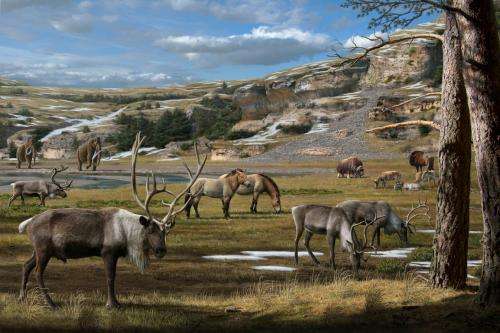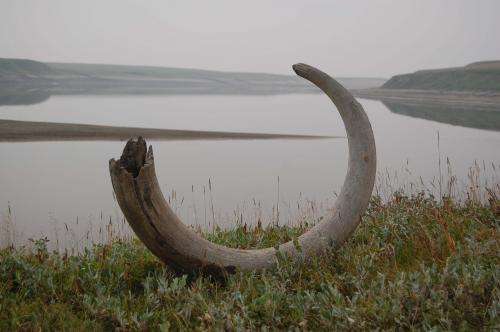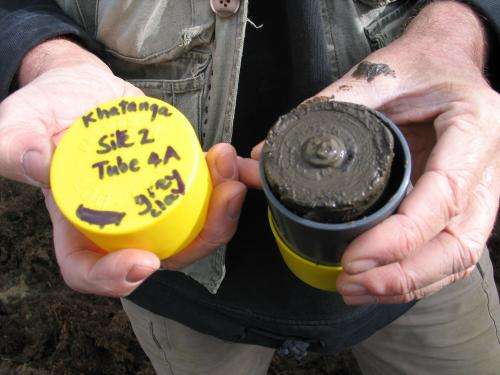Pleistocene landscape, including mammoth, horse, reindeer, bison and musk ox. Credit: Mauricio Anton
It was climate that killed many of the large mammals after the latest Ice Age. But what more specifically was it with the climate that led to this mass extinction? The answer to this is hidden in a large number of sediment samples from around the Arctic and in the gut content from permafrozen woolly rhinos, mammoth and other extinct ice age mammals.
It is a bit of a shift in paradigme Willerslev and co-workers publish in this week's edition of the journal Nature. The common image of a light-brown grass-steppe dominating the northern hemisphere during the Ice Age does not hold any longer. The landscape was far more diverse and stable than today, and big animals like woolly rhino and mammoth fed on grasses and particularly on protein-rich forbs. But at the Last Glacial Maximum 25,000 – 15,000 years ago, at a time when the climate was at its coldest and driest, a major loss of plant diversity took place. The animals barely survived.
After the Ice Age ended about 10,000 years ago it became warmer again. After the large reduction of plant diversity during the Last Glacial Maximum another kind of vegetation now appeared. One of the key food sources of the large mammals– the protein-rich forbs – did not fully recover to their former abundance. This likely proved fatal for species like woolly rhino, mammoth, and horse in Asia and North America. Even though it became warmer again after the end of the Ice Age the old landscapes did not return.
Professor Eske Willerslev, an ancient DNA researcher and director of the Centre for GeoGenetics at the Natural History Museum of Denmark, says: "We knew from our previous work that climate was driving fluctuations of the megafauna populations, but not how. Now we know that the loss of protein-rich forbs was likely a key player in the loss of the ice age megafauna. Interestingly one can also see our results in the perspective of the present climate changes. Maybe we get a hold on the greenhouse gases in the future. But don't expect the good old well-known vegetation to come back when it becomes cooler again after the global warming. It is not given that the 'old' ecosystems will re-establish themselves to the same extent as before the warming. It's not only climate that drives vegetation changes, but also the history of the vegetation itself and the mammals consuming it."
Mammoth tusk extracted from ice-complex deposits along the Logata River, Taimyr Peninsula. The ice-complex formed between 50-20 ka BP by deposition of sediment from overland flow and wind transport. Credit: Per Möller/Johanna Anjar
Footprints from past ecosystems
Professor Christian Brochmann, a botanist at the Natural History Museum at the University of Oslo in Norway, states:
We show that the permafrost contains a vast, frozen DNA archive left as footprints from past ecosystems, and that we can dechiffer this archive by exploring the collections of plants and animals stored in Natural History Museums. Using DNA from museum collections as reference, we could identify the different plant species that co-occurred with extinct ice age mammals.
Dr. Mari Moora and Professor Martin Zobel, vegetation ecologists from the University of Tartu, Estonia, say:
For the first time, ecologists have been able to piece together the characteristics of more complete plant communities occurring in the Arctic during the last 50,000 years. The new information shows clearly that the vegetation of the Late Pleistocene was rich in forbs but lost considerable diversity at the peak of the ice age. Different plant communities, with graminoids and woody plants prevailing, then started to develop during the Holocene.
Permafrost core from Taimyr Siberia. Credit: Ross MacPhee
Dr. Pierre Taberlet, an ecologist at the CNRS in France, further states: "We should realise that the results presented in this paper would have never been obtained without a very broad collaboration (30 teams from 12 countries) involving the following scientific areas: ancient DNA, palaeo-ecology, taxonomy, molecular ecology, community ecology, zoology, bioinformatics, molecular genetics, and geology. Whereas competition among scientists often is believed to be the main stimulus promoting global scientific output, this study clearly demonstrates that extensive collaboration is a viable alternative."
'Smoking gun'
The article in Nature elaborates on the Willerslev group's results from 2011 where the researchers pointed at climate as the culprit for the mass extinction of some of the large mammals'. But in 2011 the researchers lacked a 'smoking gun'. Now they got it! 242 permafrost sediment samples and eight fossil samples from large mammals from around the Arctic have been dated and analysed for DNA. The data shows that the likely main reason for the mass extinction of the large mammals after the latest Ice Age is changes in the vegetation.
More information: Paper: dx.doi.org/10.1038/nature12921
Journal information: Nature
Provided by University of Copenhagen


























